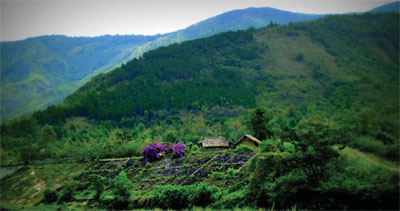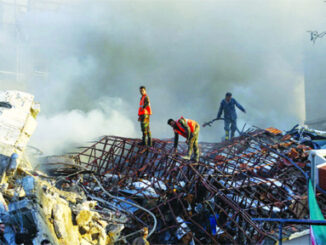
Manipur, a little Shangarila located in North-East India, is a Jewel of India. This little corner is a paradise on Earth where Mother Nature has been extra generous in her bounty. Least touched and least discovered Manipur promises to be the great tourist discovery of the 21st century. An oval shaped valley surrounded by blue green hills, rich in art and tradition has inspired description such as the Switzerland of the East? with its cascading rapids, tripling rivers, varieties of flowers, exotic blooms and lakes.
The people of Manipur include Meitei, Nagas, Kuki-Chin-Mizo and Gorkhas groups and Muslims and other colourful communities which have lived in complete harmony for centuries. These are the people whose folklore, myths and legends, dances, indigenous games and martial arts, exotic handlooms and handicrafts are invested with the mystique of nature and an indefatigable Joie de vivre.
Shaheed Minar
The indomitable spirit of the patriotic Meitei and tribal martyrs, who sacrificed their lives while fighting the British in 1891, is commemorated by this tall Minar at Bir Tikendrajit Park in the heart of Imphal city.
Khwairamband Bazar/ Ima Market
A unique all women’s market, having 3,000 or more “Imas” or mothers who run the stalls. It is splited into two sections on either side of a road. Vegetables, fruits, fishes and household groceries are sold on one side and exquisite handlooms and household tools on the other.
Kangla
The centre of Manipur’s power till 1891, the historical embodiment of Manipur Rulers and the people of Manipur, Kangla have a significant place in the heart and mind of the people of Manipur Govindajee temple, outer and inner moat and other relics are perfect reflections of the rich art and culture of Manipur and her civilization.
Shree Shree Govindajee Temple
A historic Vaishnavite centre, adjoining Manipur’s former Maharajas’ Royal Palace, the Govindajee temple is one of the most attractive sights for the tourists. Twin domes, a paved courtyard, and a large raised congregation hall form a perfect backdrop for priests who descend the steps, to accept offerings from devotees in the courtyard. The shrines of Lord Krishna and Balaram and Jagannath flank the two sides of the presiding deity. Early hours Prayer (Aarti) is a must for devoted followers, exudingspiritual fervour and ecstasy.
Manipur State Museum
This interesting Museum near the Polo Ground has a fairly good collection and display of Manipur’s tribal heritage and a collection of portraits of Manipur’s former rulers. Particularly interesting items are costumes, arms & ammunitions, relics and historical documents.
War Cemetery
Commemorating the memories of the British and Indian soldiers who died during the World War II, these War Cemeteries are managed by the Commonwealth War Graves Commission. Serene are well maintained, the War Cemetery carries little stone markers and bronze plaques recording the sacrifice of those gallant soldiers.
Manipur Zoological Garden
Manipur Zoological Garden at Iroisemba is only 6 kms. on the Imphal-Kangchup Road at the foot of the pine growing hillocks . Here apart from various endangered species, tourists can have an opportunity to see the graceful brow antlered deer (Sangai), one of the rarest & endangered species in the world, in sylvan surroundings.
Loukoi Pat
This tiny lake located near the Tiddim Road on N.H. 150 at Bishnupur is a retreat for visitors from within and outside the state. Boating facilities and the scenic beauty of the place is able to mesmerise the visitors.
Khonghampat Orchidarium
10 kms. from Imphal on National Highway No. 39 is the Central Orchidarium which covers 200 acres and houses over 110 rare varieties of orchids, which include dozens of endemic species. The peak blooming season is March- April.
Bishnupur
27 kms. from Imphal on the Tiddim Road, is a picturesque town situated at the foot hills that rolls down to the valley. The 15th century Vishnu Temple built of peculiarly small bricks supposedly of Chinese influence during the reign of King Kiyamba is of a historical importance. Bishnupur is also famous for its chiselled stoneware.
Red Hill (Lokpaching)
Red Hill is a hillock about 16 kms. from Imphal on Tiddim Road (NH – 150). It is a thrilling spot where the British and the Japanese fought a fierce battle during World War II. War Veterans had constructed “India Peace Memorial” a monument in memory of Japanese soldiers who died in the battle. It is a place of pilgrimage for Japanese tourists.
Sadu Chiru Waterfall
About 20 Kms. from Imphal beside the Tiddim Road (NH150) is a picturesque site famous for its perennial Water Fall in a scenic foot hill. There are three waterfall spots. This is a newly open tourist spot.
Kangchup
16 kms. from Imphal towards west, is a health resort on the hills over-looking the Manipur valley. The scenery is picturesque and worth seeing. With the construction of Singda Dam here, the place has become one of the important picnic spots.
Loktak Lake
48 Kms. from Imphal, is the largest fresh water lake in the North East Region. From the Tourist Bunglow set atop Sendra Island, visitors get a bird’s eye view of life on the Lake small islands that are actually floating weeds on which the Lake-dwellers live in the backdrop of the shimmering blue water of the Lake, labyrinthine boat routes and colourful water plants. The Sendra Tourist Home with an attached Cafeteria is an ideal tourist spot. Boating and other water sports are organised here in Takmu Water Sports Complex.
Moirang
45 kms. from Imphal, and situated near the Loktak lake, this town is one of the main centres of early Meitei folk culture with the ancient temple of the pre-hindu deity, Lord Thangjing, situated here. In the month of May, men and women, dressed in colourful traditional costumes sing and dance in honour of the Lord at the Moirang “Lai Haraoba” which is a ritual dance festival held every year.
This town also has a special place in the history of the Indian Freedom struggle. It was at Moirang that the flag of the Indian National Army was first unfurled on April 14, 1944. The INA Museum containing letters, photographs, badges of ranks and other memorabilia reminds the visitors of the noble sacrifices made by the INA under the charismatic leadership of Netaji Subhas Chandra Bose.
Keibul Lamjao National Park
The only floating National Park in the world, on the Loktak Lake is the last natural habitat of the Sangai (Rucervus eldii eldii) the dancing deer of Manipur. A glimpse of the deer in this unique wetland ecosystem is a must for any wildlife enthusiast. Other wildlife to mention a few are: Hog deer, Otter and a host of water fowls and migratory birds can also be sighted during November to March. The forest Department of Manipur maintains watch towers and two rest houses within the park.
Khongjom War Memorial
Khongjom War Memorial, 36 kms. from Imphal on the Indo-Myanmar road is a major historical place. It was here that Major General Paona Brajabashi, one of the great warriors of Manipur proved his valor against the superior might of the invading British Army in 1891. The hillock at the foot of which he laid down his life in defence of his motherland, is reminiscent of the past heroic deeds of Manipuri warriors. A war memorial has been constructed on the top of Kheba hill; and Khongjom day is celebrated every year on 23rd April.





Be the first to comment